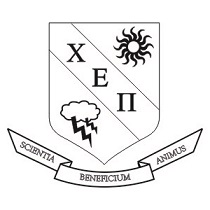Top Qs
Timeline
Chat
Perspective
Chi Epsilon Pi
American meteorological honor society From Wikipedia, the free encyclopedia
Remove ads
Chi Epsilon Pi (ΧΕΠ) (Also known as XEP) is an American honor society for outstanding students in the field of meteorology/atmospheric sciences. It was established at the University of California, Los Angeles in 1951. It has chartered 13 chapters at various institutions in the United States.
Remove ads
History
Chi Epsilon Pi was founded at Department of Atmospheric and Oceanic Sciences of University of California, Los Angeles in 1951.[1][2][3] It is an honor society for students in the field of atmospheric sciences.[4] It promotes the advanced study of meteorology and related field and recognizes students who demonstrate a "promise of achievement: as professionals in the field.[4]
The UCLA chapter was originally formed to recognize graduate students but began also honorary undergraduates in 2019.[1] The local society became national in 1963 with the chartering of its second chapter at Texas A&M University.[3]
Its national office is housed at 405 Hilgard Avenue, 7127 Math Sciences Building in Los Angeles, California.[5]
Remove ads
Symbols
The name Chi Epsilon Pi {ΧΕΠ} was selected to represent ΧΕΙΜΩΝΑΣ ΕΗΙΟΝΤΑΣ ΠΡΟΛΕΓΟΜΕΝ or "Past Events Cast Their Shadows Before Them."[3] The society's colors royal blue and silver.
Membership
Chi Epsilon Pi has active, alumni, and honorary members.[2] Active members include students who have completed ten credits toward a meteorology major with a 3.0 cumulative GPA.[2][6] However, chapters may set higher standards. Alumni have either graduated, transferred to another institution, or changed majors.[2] Honorary membership are presented to individuals who have completed advanced study of meteorology and receive a majority vote of active chapter membership.[2]
Chapters
Remove ads
Notable members
- Elliot Abrams, meteorologist who works for AccuWeather[15]
- Jeffrey Frame (2001), professor at the University of Illinois at Urbana-Champaign and atmospheric scientist for VORTEX2[16]
- Frederick W. Leslie, scientist who flew on the NASA STS-73 Space Shuttle mission as a payload specialist[17]
- David Stensrud, research meteorologist with the National Severe Storms Laboratory and adjunct professor at the University of Oklahoma[18]
Remove ads
See also
References
External links
Wikiwand - on
Seamless Wikipedia browsing. On steroids.
Remove ads

